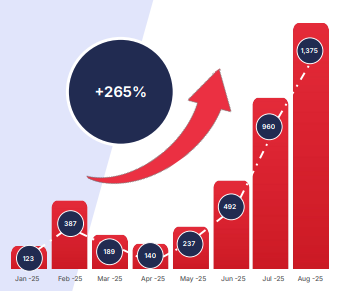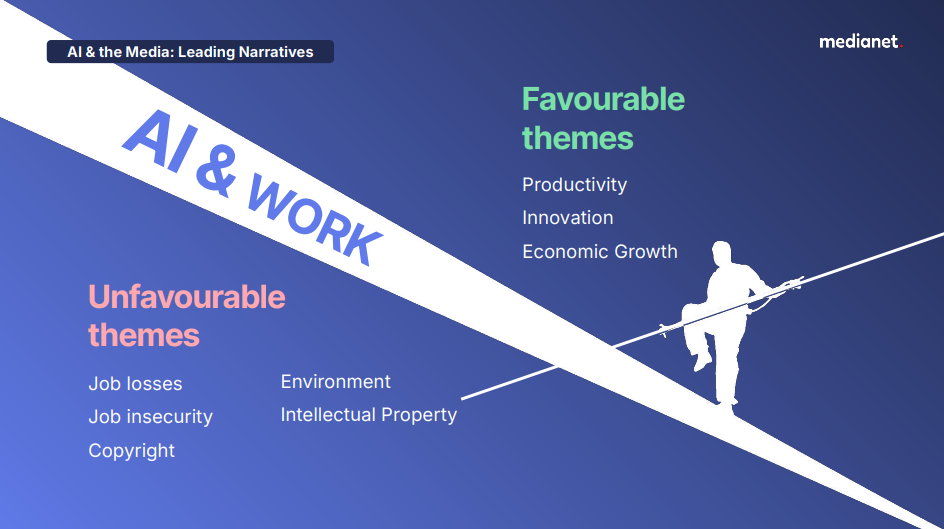A new report from media intelligence platform Medianet has recognised the reputational tightrope companies face when adopting Artificial Intelligence. Traditional media is framing it largely from a position of optimism, while social media sentiment tends to skew negative.
The AI Tightrope: Balancing AI, Reputation and Workforce Impact report analysed more than 50,000 media and social media items from the first half of this year. It found that 71 per cent of print and online coverage emphasised AI’s potential for productivity, innovation, and growth. However, negative themes tied to job cuts and restructures remained significant, particularly when amplified on social platforms, where 64 per cent of posts expressed negative sentiment.
A prominent stat in the report is the finding that union commentary on AI surged 265 per cent between May and June 2025, with unions gaining visibility in professional sectors where they have not traditionally had a strong presence. Or to think about it another way: knowledge workers are starting to freak out a bit.

Media mentions highlighting Union commentary around AI between May and June 2025 compared with the four months prior.
There’s a disconnect between white collar workers clearly identifying concerns about their job security, and the reporting in traditional media publications like The Australian and the AFR where stories are focused on AI productivity benefits.
“There is definitely more intentional engagement coming from the unions and that’s going to contribute to more of a voice,” Medianet Head of Insights Jacquie Hanna told Mediaweek.
Hanna believes that the media is generally being even-keeled in its coverage, acknowledging the stresses on workers: “I think potentially the AFR and those kinds of major financial services or industry trade publications, what they’re noticing is that these conversations are no longer just in the shareholders’ offices and no longer just in the boardroom. They’re actually now permeating their employees’ lives and the broader Australian population.
“[In the AFR] There’s just a kind of broader acceptance that AI is going to be inevitable. So instead of talking about will they/won’t they, it’s more talking about which businesses are doing it better,” Hanna said.
Media optimism, public scepticism
For companies going through AI-fuelled structural change, it is important that business leaders maintain a consistent view on how the organisation is working with AI processes and systems, along with what that impact will be on staff.
“AI has become as much a reputation story as a technology story,” said Amrita Sidhu, Managing Director at Medianet. “Our research shows corporate leaders are driving optimism in the headlines, but public cynicism is growing louder online. Navigating this gap is now a frontline issue for communication and corporate affairs professionals.”
Hanna added: “The media loves a bad news story, and when disgruntled employees speak out, a company’s carefully curated messaging can unravel quickly. Emotive language from employees and unions tends to go viral and spill onto social channels.”
Case studies in the report point to the Commonwealth Bank’s transparent communication strategy, which helped neutralise backlash around AI-related job cuts, while inconsistent messaging from Telstra fuelled union criticism and negative headlines.

Recommendations for communicators
The report outlines several strategies for companies to manage reputational risks when implementing AI:
• Showcase expertise – thought leadership can help fortify reputation during difficult decisions.
• Maintain consistent messaging – inconsistencies around job cuts are quickly highlighted by unions and amplified in media.
• Be transparent – acknowledge the impact of AI and emphasise workforce reskilling rather than focusing solely on cost savings.
“Companies must anticipate and manage the perspectives of stakeholders, including unions, and articulate a clear ‘why’ behind any workforce changes,” Hanna said. “The focus should be on reskilling and higher-value roles rather than just headcount reduction.”
Hanna comes back to her belief that consistency is key.
“Whatever engagement you have, whether you’re talking to your shareholders, you’re talking to your employees, you’re talking to the media, you have to maintain a consistent line.
“The report unpacked the difference between Telstra and CommBank, where despite the fact that there was a bit of an issue with CommBank and they did have to walk back some of their announcements, they had maintained a very consistent line over the last 12 months, which is: ‘This is coming, this is actually going to be better for our customers’. Also emphasising the positive impacts on customers as well is a really good way of getting strong kind of positive coverage of your AI developments. But he also was really frank about the impact it was going to have on workforces, and he acknowledged this and talked about ways, genuine ways, to reskill and retrain staff so that they could enter into this new world.
“That’s an example of where he has been able to ride some of that negative coverage just a little bit more effectively, because there was very consistent messaging in all channels. So he told his shareholders, this is going to bring benefits, but it’s also going to have impacts. And he told the same message to employees as well.
“In the case of Telstra, there was a little bit of jumping around. And that’s what the media picked up on. Telstra weren’t as upfront about the link between AI and workforce restructure. And that’s made it a little bit more challenging for them to navigate.
“Consistency is key and making sure that you’re emphasising what contingencies are in place to manage those workforce impacts for a very long time… not just a month before you announce the change.”
